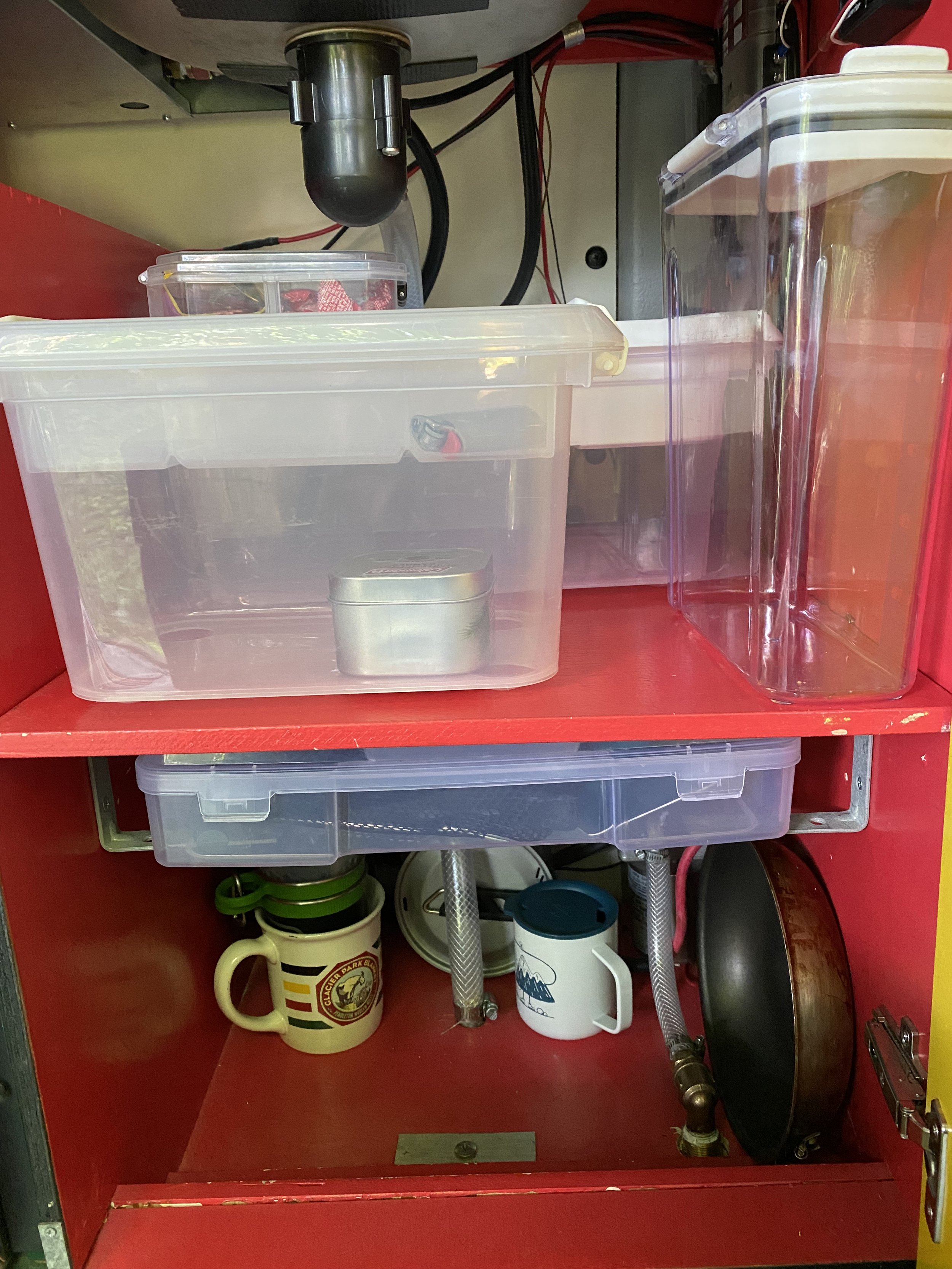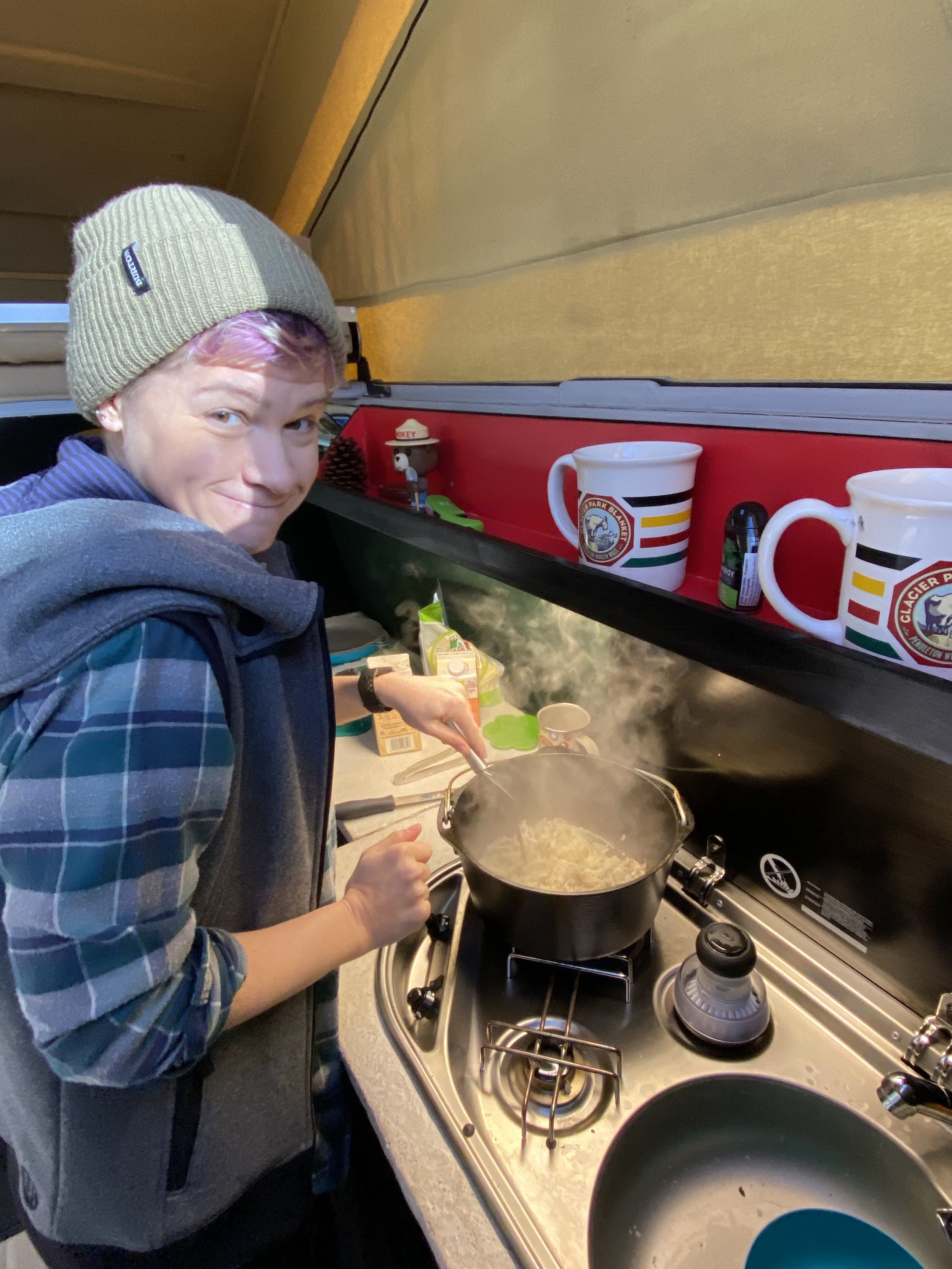Trip Fundamentals - Kitchen and Food Basics
When we first started roadtripping over 20 years ago, we always left home with a cooler and food care package my grandmother packed for us. It included cookies, Fruit Snack gummies, Cheez-its, and Toast-Chee peanut butter crackers. We bought some hot dogs and Doritos to round out our days, and that was what we ate for 2 full weeks. Since we are no longer in our mid-20’s, that type of diet really doesn’t serve us any longer.
Having a functional kitchen space in our VW Vanagon is such a luxury. We both still love cooking over a campfire, but realizing fire bans in the Western United States may limit that type of cooking, our van’s kitchen has been a really great addition to our travels.
Here’s how we take full advantage of our kitchen area:
Planning Meals
We are huge supporters of weekly meal planning. In our day-to-day life, we always prep out our weekly food so we can have one less thing to worry about at the end of the work day. Traveling in the van is no exception. We plan quick, easy and healthy meals to have on the road. One of the things that has really helped this process is doing as much food prep as possible before we go. We chop veggies, separate foods into containers, and marinate any proteins. Anything that we can do ahead of time, we do. This will make meal time go much easier and quicker. We also have found that dehydrating foods has worked out for us. This is especially helpful when we are backpacking. Dehydrating foods yourself is a much cheaper, and more delicious, alternative to buying the prepackaged meals at your local sporting goods store.
We try to take a couple different proteins to eat, normally chicken and a lunch meat or tuna package. We make sure that whatever we’re taking can be prepared easily on our burners or a campfire. From there, we plan a few side dishes: rice, salad, dehydrated potatoes, mac and cheese... things that are simple and easy to fix. Some sides, such as rice, are cooked ahead of time at home, and we will just heat it up over a burner. Making a salad ahead of time just takes a little chopping and you’re ready to go! And we’ve always found that wrapping various ingredients in a tortilla or wrap will satisfy our hunger. For snacks, we pack a handful of Send Bars. They are superfood bars that are made with ZERO artificial anything. These help properly fuel our minds/bodies on the road when we don’t have the time/patience to cook up some real food.
With tortillas, you can use different combos of carefully chosen versatile ingredients you have on hand for a great meal.
Packing Food
Maximizing space is the name of the game. We really took some time researching the storage that works for us. We knew we needed items that would be small and flexible, but also needed some hard-sided storage to make sure we kept critters at bay. The hard-sided storage containers we use are actually sold as art supply boxes. These are deep enough for us to pack our various soft-sided items in. These boxes also include a removable top divider, which holds smaller food items for us. They lock closed and have (so far) kept out any rodents looking for a snack. We have also invested in a condiment container, which holds small individual packages of ketchup, mustard, etc. This keeps us from packing large bottles in our fridge and frees up space there.
For our smaller storage, we’ve opted for reusable bags made by (Re)Zip. These bags not only squish down to the sizes we need for them to be, but they hold in a good amount of odor from smellier foods. They seal tight, so we don’t have to worry about something falling open in the fridge. They come in a variety of sizes, so it’s pretty easy to find something that can fit your needs. We always carry extra bags for leftovers and anything else that may come up while we’re traveling.
Something else to consider when packing food is spices and dressings. There are so many times we’ve traveled and we’ve wished we could have just sprinkled a little extra seasoning on something. We purchased some very tiny spice containers made by GSI Outdoors to carry a few spices in. We also have very cool little squeeze containers meant to put salad dressing or oils in. Remembering simple things like that can elevate a meal very easily.
Our storage system keeps evolving over time. It’s getting pretty space-efficient!
Dinner and Cookware
Dishes, pots, pans and skillets can take up a lot of space. It’s a good idea to think through all the things you may pack on a longer trip. We typically try and pack as light as possible when going out for a week or more. If we’re camping a few hours away for a weekend, the cast iron skillets and pot would probably travel with us. For the sake of this blog entry, I’m discussing longer trips. We carry one lightweight saucepot made by Sea to Summit that has a strainer built into the lid, one skillet made by GSI that has a foldable handle, two Sea to Summit Delta plates that stack into each other, two Sea to Summit collapsible bowls, two coffee mugs, two cups, a utensil set and an Aeropress coffee press. Our dishes and utensils are put away into a flat, hard sided container and kept out of the way until needed. Almost everything we travel with is made for backpacking or camping (except our coffee mugs…I’m not giving my mug up). This means that they are super lightweight and very durable. We can make full meals out of our modest set of cookware with no issue.
Something else that has come in quite handy for us is the UST Pack-A-Long Grill. We purchased it a few years ago on a whim, and it’s been a nice addition. There are certain fire bans in some states that won’t allow for a campfire in a ring, but will allow a charcoal grill to be lit. Having that little luxury makes cooking much easier, tastier some nights. It beats cleaning up a dirty cooktop and dishes as well.
Other Tips
When prepping meals, always think of how they will clean up. Some meals may make a big mess to prepare. Some won’t. Also, be sure all food at the end of the night is properly put in it’s place. Early on in our travels, we didn’t stick to this and had some unwelcome visitors scurrying around our van while we were trying to sleep. Now, we are sure to wash all of our dishes and make sure any food scraps are properly disposed of. All it takes is one bit of food to invite a mouse in to infiltrate your set up.
It took us WAY too long to figure this one out—visit the local farmers markets and food stands while traveling. Not only does visiting local markets ensures you will be getting fresh, delicious produce, but it also helps the economy of the area you are visiting. In Michigan, we stopped at a local food market and ended up getting some of the best strawberries we’ve ever had. We also visited a fish market in Florida and had some very fresh Gulf of Mexico shrimp that we still think about on a weekly basis. Always leave room in your cooler or fridge for what you may find in the areas you visit.
And our last tip, bring an extra cooler. We have a small, soft sided Ice Mule cooler that rolls up. We take it with us if we decide to take a picnic lunch out somewhere we have to walk to. Or, let’s be real, it can carry all the extra beer that you buy at local breweries! In any case, a small cooler is never a bad idea to have.
Hopefully, this can help you have an easier time packing for your kitchen. I honestly love being able to fix our meals on the road. It’s cheaper and healthier than stopping at a truck stop.
If you’ve got some tips, We’d love to hear them!
Next up… how to keep yourself clean and fresh on the road!



